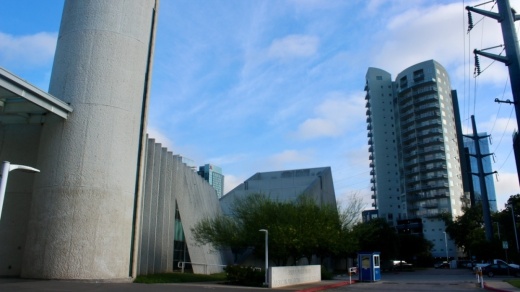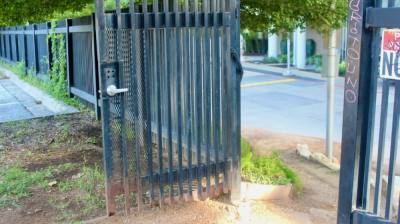The concept of continuing Red River south from its current endpoint at Davis Street in the Rainey Street Historic District has cropped up in city and local planning documents for years and was revived this summer by the Austin Transportation Department. The idea at various points has been floated as an option to relieve the often-congested Rainey Street, make the area safer for pedestrians and cyclists, and improve access to the Emma S. Barrientos Mexican American Cultural Center, or ESB-MACC, but it had never moved into a firm planning stage.
“Essentially, everybody’s just kind of affirmed that this is a good idea, and now we’re at the point where we have enough pieces in place to kind of do a feasibility study through and through to determine if this can move forward and if it benefits all the people that we think it will benefit," said Dan Hennessey, a consulting engineer with ATD's project development program.
With city planning in its early stages, Hennessey said next steps in the department's public listening process could include additional community meetings and online engagement opportunities. But while city staff consider what form the project may take, if any, some Rainey-area residents have already made it clear they do not want the city's vision of a Red River extension to proceed despite the growth and mobility concerns that have been a constant in the rapidly developing district for years.
“We’re trying to be practical with respect to this. We understand that we live in an area that’s going to be developed; it’s almost monthly we see a new project coming to fruition over here," said Robert Hollingsworth, president of The Shores condominium homeowners association board opposing the plan. "We know that we have to be, to some degree, accommodating. But we don’t want to lose the functionality of our building. And I don’t think we should.”
MACC opposition
The Shores is one of several existing or proposed buildings located along the path of the potential Red River reroute, adjacent to the ESB-MACC and separated by a fence and grade difference of several feet. To its south, the ESB-MACC is situated on around 6 acres of parkland located west of Rainey off River Street.
Based on a draft outline of the city's Red River extension, a two-way road could run south along the Kimpton Hotel Van Zandt and Shores buildings through the ESB-MACC property and parking lot, prompting concern from several ESB-MACC board and community members in recent weeks.
“As a representative stakeholder and participant in MACC events and considering myself one of the community founders, we are adamantly and totally opposed to any part of the extension of Red River reaching any part, one inch of MACC property," said resident Martha Cotera, a former ESB-MACC board member, during a special board meeting Aug. 17. "We will hold fast on this."
Other participants in the Aug. 17 session also expressed their opposition to the project through the lens of the neighborhood's ongoing cultural transformation. Several residents voiced frustration that a city takeover of a portion of ESB-MACC land represented the state of Mexican American heritage in the Rainey district and accommodation of neighboring bars and developments before the local community.
"I’m sorry for being upset. ... Over and over and over we are under constant assault from developers, from clueless white staff people who don’t understand their effect on us," Daniel Llanes said. "Just back off this idea of putting Red River through the parking lot.”
After several residents spoke during that meeting, ESB-MACC board members unanimously voted for passage of a resolution requesting that City Council cancel any Red River project that would stretch onto the cultural center's property. The ESB-MACC board's executed resolution, read during the meeting by Chair David Goujon, also highlighted the cultural concerns stemming from the proposal. The document stated that the project would "further devastate" the district while "cannibalizing" the ESB-MACC's parkland and disrupting its operations.
That sentiment was also shared by board Vice Chair Art Navarro, who said prior to the Aug. 17 session that construction would be likely to affect the cultural center's indoor and outdoor programming for months or years.
“It’s going to shake the windows and rattle the walls of the MACC when you have 18-wheeler cement trucks, all manner of vehicles, coming and going through the proposed road. ... Speaking for myself, that’s not something that I can accept," Navarro said. “I don’t know that there’s any way to improve upon the idea of a road going through the MACC."
District 9 Council Member Kathie Tovo said she had not followed the Aug. 17 ESB-MACC board session, but she attended an earlier meeting between community members and ATD regarding the Red River proposal. Tovo noted that project planning remains in its earliest stages with additional public feedback opportunities to come, and she also said she shared some community reservations about the plan as it moves along.
“I certainly take [the board's] opinion seriously and believe it’s important," Tovo said. "I think it’s important that any mobility strategies that are being considered really work well for the MACC and for the visitors and those who have supported the MACC."
Prior to the August board meeting, the Austin Parks and Recreation Department, or PARD, said it was working with the transportation department on project planning with an aim to avoid affecting the cultural center.
"PARD is coordinating with ATD to ensure minimal impact to the MACC from the Red River extension project. PARD will also evaluate potential benefits to the MACC, including improved connectivity and transit access, increased visibility and possible funding for the underground parking structure at the MACC," the department said in a statement.
In a separate statement following the August ESB-MACC board meeting, the transportation department also said it would keep in contact with local stakeholders as it moves through its planning process.
"ATD will work together with the community—including the ESB-MACC board, the parks and recreation department and other interested stakeholders—to both improve both overall mobility in the neighborhood and connectivity for the ESB-MACC as the center continues toward completing its long-term vision," ATD said.
Mobility questions remain
In the meantime, the Rainey district is still facing mobility issues related to its changing skyline, population and nightlife. Rainey Street itself on weekend nights is frequently clogged with cars, pedestrians and bicycles or scooters, a situation that spills onto neighboring streets and which Tovo said the city must confront regardless of a Red River extension.
“It can be a very dangerous situation in the evening along Rainey Street, near the MACC, in the vicinity in any of the surrounding areas," Tovo said. "It is really important that those who live in or are involved in businesses or involved in the MACC really sit down and look carefully at some of the mobility, some of the solutions, and talk about what might be feasible and could be supported. Because we need those changes.”
Transportation is also a concern for residents of buildings such as The Shores, and the proposed Travis tower that could soon rise next door. In addition to traffic flowing around the district's central road, Hollingsworth noted that residents around Red River are also wary of changes to the private driveway that could become the foundation for Red River's extension.
The Shores residences are presently accessible via that route that operates at a low speed limit and with no public access, allowing residents and delivery drivers to slowly enter or exit. In addition to engineering concerns related to grade and drainage there, Hollingsworth said an expanded public road through the area—despite being designed with safety in mind—would likely see its uses frequently limited by residents, visitors and commercial vehicles.
With mixed sentiments in the community, Hennessey said the city transportation department is now focused on gathering input on the project before setting any firm plans in place. While a draft outline of the road extension has been presented, he said continued public feedback and design work will stretch well into next year, and construction—if the project reaches that point—beginning "optimistically" in 2024 at the earliest.
"From the neighborhood perspective, they have been fairly vocal that they’re looking for any solutions to help mitigate some of the conditions of the narrow streets that have been there for a very long time," Hennessey said. "This is really our crack at a significant improvement to that area, where we can add capacity in a responsible way that’s not a wide street, a high-speed street, but that makes an important connection."
Information on the city's Red River project and other Rainey district improvements is available online.








